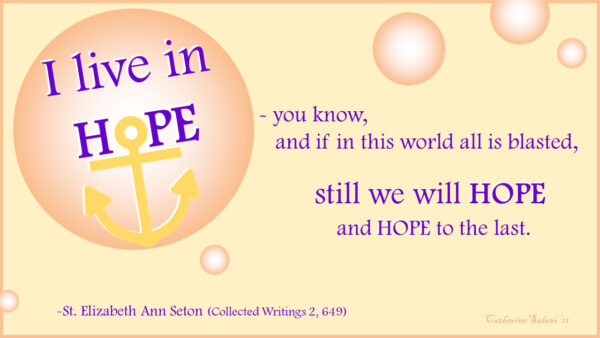
“I live in hope – you know, and if in this world all is blasted, still we will hope and hope to the last.” – St. Elizabeth Ann Seton
(Elizabeth Bayley Seton, Collected Writings, Volume 2, 649)
Hope by its nature desires something in the future, and expects to receive it. This virtue is commonly depicted as “a sure and steadfast anchor of the soul”. (Hebrews 6:19) Thus, hope also steadies the present setbacks and difficulties that may otherwise seem discouraging and overwhelming – “when all is blasted”. In both instances (future expectations and present reality), hope, “infused into our soul by God alone” (St. Thomas Aquinas), perseveres through unpredictable outcomes.
St. Elizabeth Ann shares an insight into hope. Her words begin with “I live in hope” then change to “we will hope”. Whether the shift was intuitive or intentional, the collaborative quality of hope is significant and worth highlighting. Human connection animates hope – by anticipating something favorable or responding to something troubling. Aquinas, like Mother Seton, suggests there are far more reasons to be hopeful “when we have friends to rely on”. Hope, then, is interpersonal and at the root of our collective well-being. The world heals a bit, when hope is shared or witnessed. Hope put into action is an investment in our future, a spirited desire for a greater good. While no one is exempt from challenges and uncertainty, human connection can strengthen our resolve, reinforcing God’s indwelling gift of hope.
Although life does not always give us what we hope for, it can remind us of the blessings that are often overlooked, the relationships we rely on and the unexpected goodness within our reach. Live in hope and hope to the end. We got this.
– Catherine Salani (SC collaborator, educator, artist)

Really insightful reflection on Hope and the importance of good friendships and relationships.
Much remains to be in God’s hands, yet it is a hope sustainer when I have good friends to also express solidarity and need with. Faith invites me to reach out in hope for help and understanding. Thanks Cath for these words of yours and of our dear “Mother” Seton.
Beautiful message on hope. Seems like God really intended us to walk with one another snd encourage one another along life’s journey. Hope being fostered snd upheld by another is a wonderful gift.
Thank you for your beautiful writings